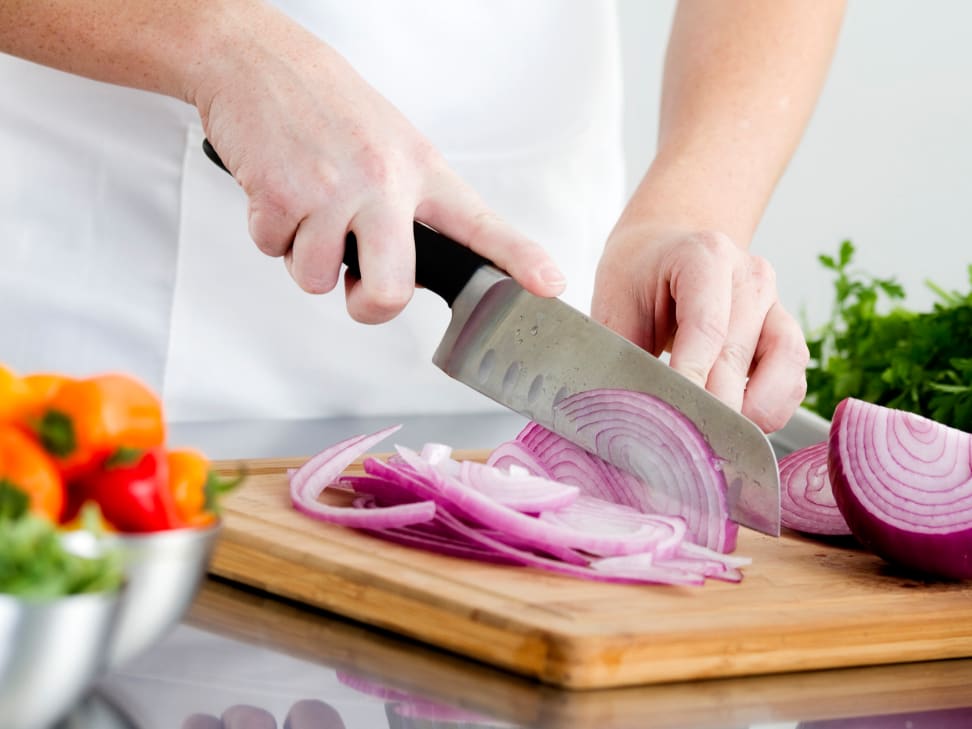Onions, an indispensable ingredient in countless culinary creations, are infamous for their pungent aroma and ability to elicit tears. The sharp, sulfuric compounds released when cutting onions irritate the eyes, triggering a reflex response that leads to tearing. However, with the right techniques and understanding of the science behind onion tears, this annoying side effect can be effectively avoided.
Why Do Onions Make Us Cry?

The culprit behind onion tears is a volatile substance known as syn-propanethial-S-oxide (SPSO). This chemical is released into the air when onion cells are damaged, such as during cutting or chopping. The SPSO molecules then reach the eyes, where they bind to sensory nerves and trigger a response that stimulates tear production. The tears serve as a protective mechanism, flushing out the irritants from the delicate eye tissue.
Chemical Composition of Onions
Onions belong to the genus Allium and contain a complex mixture of organic compounds. These compounds include:
- Sulfur compounds (e.g., syn-propanethial-S-oxide)
- Flavonoids (e.g., quercetin, kaempferol)
- Amino acids
- Vitamins (e.g., vitamin C, vitamin B6)
- Minerals (e.g., potassium, calcium)
The specific composition of onions can vary depending on the cultivar, growing conditions, and storage methods. However, the presence of syn-propanethial-S-oxide is a common characteristic of all onions.
Mechanism of Tear Inducement
When onion cells are damaged, syn-propanethial-S-oxide is released into the air. This volatile compound diffuses through the air and reaches the eyes. The SPSO molecules bind to sensory nerves in the eyes, particularly in the trigeminal nerve. This binding triggers a reflex response that leads to tear production. Tears are produced by the lacrimal glands, located above the eyes. The tears contain a variety of substances, including water, electrolytes, and proteins, which help to flush out the irritants and protect the ocular surface.
Tips for Cutting Onions Without Tears
Armed with the knowledge of what causes onion tears, let’s explore practical tips to avoid this watery distraction:
Pre-Cutting Techniques
Chilling the Onions
Before cutting, refrigerate onions for at least an hour. Chilling slows down the release of SPSO, reducing the intensity of the irritant. Cold temperatures reduce the volatility of SPSO, preventing it from escaping into the air and reaching the eyes.
Using a Sharp Knife
A sharp knife cuts through onion cells cleanly, releasing less SPSO. Sharpen your knives regularly for optimal performance. Dull knives crush or tear the onion cells, releasing more of the irritant. A sharp knife makes a clean, precise cut, minimizing cell damage and SPSO release.
Cutting Under Running Water
This technique effectively captures the released SPSO molecules before they reach your eyes. Place the onion under a stream of cold running water while cutting. The water will carry away the SPSO and prevent it from irritating your eyes. However, it is important to note that this technique may not be effective for everyone, as some individuals may be more sensitive to SPSO than others.
Other Methods
Wearing Goggles or Contact Lenses
Goggles or contact lenses can act as a physical barrier between your eyes and the SPSO molecules. They can effectively prevent the irritant from reaching the sensitive nerves in your eyes. However, it’s important to ensure that the goggles or contact lenses fit comfortably and do not cause any discomfort or irritation.
Using an Onion Holder
An onion holder is a specialized kitchen tool designed to hold the onion in place while cutting. It typically features sharp spikes that pierce the onion and keep it steady. By stabilizing the onion, an onion holder reduces the risk of accidental slipping or cutting, which can lead to more SPSO release.
Cutting Onions Near a Fan
Placing a fan near the cutting area can help to disperse the SPSO molecules away from your eyes. The fan will create a draft that carries the irritant away, reducing its concentration in the air. However, it is important to ensure that the fan is not blowing directly into your face, as this can cause further irritation.
The Science Behind Onion Tears
As mentioned earlier, the release of SPSO is responsible for onion tears. However, there are other factors that can influence the intensity of the tear-inducing effect:
Onion Variety
Different onion varieties contain varying levels of SPSO. For example, yellow onions tend to have a higher concentration of SPSO compared to red or white onions. Therefore, cutting a yellow onion may result in more intense tears.
Growing Conditions
The amount of sulfur in the soil and water where onions are grown can affect their SPSO content. Onions grown in sulfur-rich environments may have a higher concentration of SPSO, leading to more tears when cut.
Storage Methods
Onions stored in cool, dry conditions tend to have a lower concentration of SPSO compared to those stored in warmer, humid environments. Therefore, properly storing onions can also help reduce the intensity of onion tears.
How to Avoid Crying While Chopping Onions
In addition to the tips mentioned above, here are some additional steps you can take to minimize onion tears while chopping:
- Cut onions near a window or open door to allow for better air circulation.
- Use a sharp, non-serrated knife to make clean cuts.
- Cut the onion in half and remove the root end before peeling off the skin.
- Cut the onion with the root end facing away from you, as this part contains the highest concentration of SPSO.
- Take breaks between cutting onions to allow your eyes to recover.
- Chew gum while cutting onions to prevent yourself from breathing through your mouth, which can lead to more SPSO reaching your eyes.
While onion tears may seem inevitable, understanding the science behind them and implementing the right techniques can significantly reduce their impact. From chilling the onion to cutting under running water, there are various methods you can try to avoid crying while chopping onions. So next time you’re in the kitchen, put these tips into practice and master the art of cutting onions without tears.


